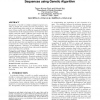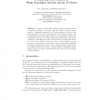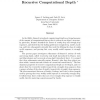10602 search results - page 1 / 2121 » Weakly Useful Sequences |
ICALP
1995
Springer
13 years 8 months ago
1995
Springer
An infinite binary sequence x is defined to be (i) strongly useful if there is a computable time bound within which every decidable sequence is Turing reducible to x; and (ii) w...
GECCO
2006
Springer
13 years 9 months ago
2006
Springer
Recognition of motifs in multiple unaligned sequences provides an insight into protein structure and function. The task of discovering these motifs is very challenging because mos...
CSL
2005
Springer
13 years 10 months ago
2005
Springer
We study computability on sequence spaces, as they are used in functional analysis. It is known that non-separable normed spaces cannot be admissibly represented on Turing machines...
TIP
2008
13 years 5 months ago
2008
In this paper, we present an automatic classification framework combining appearance based features and Hidden Markov Models (HMM) to detect unusual events in image sequences. One...
ICALP
1997
Springer
13 years 9 months ago
1997
Springer
In the 1980's, Bennett introduced computational depth as a formal measure of the amount of computational history that is evident in an object's structure. In particular,...



